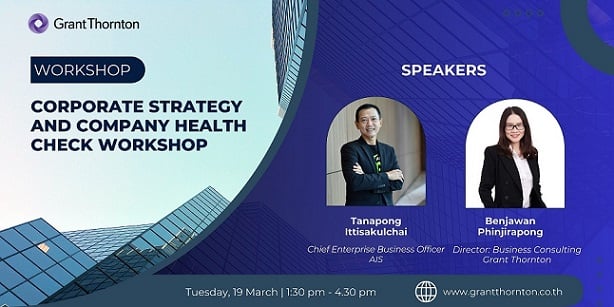-
Internal audit
In today's increasingly competitive and regulated market place, organisations - both public and private - must demonstrate that they have adequate controls and safeguards in place. The availability of qualified internal audit resources is a common challenge for many organisations.
-
IFRS
At Grant Thornton, our International Financial Reporting Standards (IFRS) advisers can help you navigate the complexity of financial reporting so you can focus your time and effort on running your business.
-
Audit quality monitoring
Having a robust process of quality control is one of the most effective ways to guarantee we deliver high-quality services to our clients.
-
Global audit technology
We apply our global audit methodology through an integrated set of software tools known as the Voyager suite.
-
Looking for permanent staff
Grant Thornton's executive recruitment is the real executive search and headhunting firms in Thailand.
-
Looking for interim executives
Interim executives are fixed-term-contract employees. Grant Thornton's specialist Executive Recruitment team can help you meet your interim executive needs
-
Looking for permanent or interim job
You may be in another job already but are willing to consider a career move should the right position at the right company become available. Or you may not be working at the moment and would like to hear from us when a relevant job comes up.
-
Practice areas
We provide retained recruitment services to multinational, Thai and Japanese organisations that are looking to fill management positions and senior level roles in Thailand.
-
Submit your resume
Executive recruitment portal
-
Update your resume
Executive recruitment portal
-
Available positions
Available positions for executive recruitment portal
-
General intelligence assessments
The Applied Reasoning Test (ART) is a general intelligence assessment that enables you to assess the level of verbal, numerical reasoning and problem solving capabilities of job candidates in a reliable and job-related manner.
-
Candidate background checks
We provide background checks and employee screening services to help our clients keep their organisation safe and profitable by protecting against the numerous pitfalls caused by unqualified, unethical, dangerous or criminal employees.

-
Capital markets
If you’re buying or selling financial securities, you want corporate finance specialists experienced in international capital markets on your side.
-
Corporate simplification
Corporate simplification
-
Expert witness
Expert witness
-
Family office services
Family office services
-
Financial models
Financial models
-
Forensic Advisory
Investigations
-
Independent business review
Does your company need a health check? Grant Thornton’s expert team can help you get to the heart of your issues to drive sustainable growth.
-
Mergers & acquisitions
Mergers & acquisitions
-
Operational advisory
Grant Thornton’s operational advisory specialists can help you realise your full potential for growth.
-
Raising finance
Raising finance
-
Restructuring & Reorganisation
Grant Thornton can help with financial restructuring and turnaround projects, including managing stakeholders and developing platforms for growth.
-
Risk management
Risk management
-
Technology & Digital Services
Technology Services
-
Transaction advisory
Transaction advisory
-
Valuations
Valuations
-
Human Capital Consulting
From time to time, companies find themselves looking for temporary accounting resources. Often this is because of staff leaving, pressures at month-end and quarter-end, or specific short-term projects the company is undertaking.
-
Strategy & Business Model
Strategy & Business Model
-
Process Optimisation & Finance Transformation
Process Optimisation & Finance Transformation
-
System & Technology
System & Technology
-
Digital Transformation
Digital Transformation
-
International tax
With experts working in more than 130 countries, Grant Thornton can help you navigate complex tax laws across multiple jurisdictions.
-
Licensing and incentives application services
Licensing and incentives application services
-
Transfer pricing
If your company operates in more than one country, transfer pricing affects you. Grant Thornton’s experts can help you manage this complex and critical area.
-
Global mobility services
Employing foreign people in Australia, or sending Australian people offshore, both add complexity to your tax obligations and benefits – and we can guide you through them.
-
Tax compliance and tax due diligence review services
Tax compliance
-
Value-Added Tax
Value-Added Tax
-
Customs and Trade
Customs and Trade
-
Service Line
グラントソントン・タイランド サービスライン
-
Business Process Outsourcing
Companies, large and small, need to focus on core activities. Still, non-core activities are important, and they need to be leaner and more efficient than most companies can make them sustainably. For Grant Thornton, your non-core activities are our core business. Grant Thornton’s experienced outsourcing team helps companies ensure resilience, improve performance, manage costs, and enhance agility in resourcing and skills. Who better to do this than an organisation with 73,000 accountants? At Grant Thornton we recognise that that outsourcing your F&A functions is a strategic decision and an extension of your brand. This means we take your business as seriously as we take our own.
-
Technology and Robotics
We provide practical digital transformation solutions anchored in business issues and opportunities. Our approach is not from technology but from business. We are particularly adept at assessing and implementing fast and iterative digital interventions which can drive high value in low complex environments. Using digital solutions, we help clients create new business value, drive efficiencies in existing processes and prepare for strategic events like mergers. We implement solutions to refresh value and create sustainable change. Our solutions help clients drive better and more insightful decisions through analytics, automate processes and make the most of artificial intelligence and machine learning. Wherever possible we will leverage your existing technologies as our interest is in solving your business problems – not in selling you more software and hardware.
-
Technical Accounting Solutions
The finance function is an essential part of the organisation and chief financial officer (CFO) being the leader has the responsibility to ensure financial discipline, compliance, and internal controls. As the finance function is critical in every phase of a company’s growth, the CFO role also demands attention in defining business strategy, mitigating risks, and mentoring the leadership. We offer technical accounting services to finance leaders to help them navigate complex financial and regulatory environments, such as financial reporting and accounting standards, managing compliance requirements, and event-based accounting such as dissolutions, mergers and acquisitions.
-
Accounting Services
Whether you are a local Thai company or a multinational company with a branch or head office in Thailand you are obliged to keep accounts and arrange for a qualified bookkeeper to keep and prepare accounts in accordance with accounting standards. This can be time consuming and even a little dauting making sure you conform with all the regulatory requirements in Thailand and using Thai language. We offer you complete peace of mind by looking after all your statutory accounting requirements. You will have a single point of contact to work with in our team who will be responsible for your accounts – no matter small or large. We also have one of the largest teams of Xero Certified Advisors in Thailand ensuring your accounts are maintained in a cloud-based system that you have access to too.
-
Staff Augmentation
We offer Staff Augmentation services where our staff, under the direction and supervision of the company’s officers, perform accounting and accounting-related work.
-
Payroll Services
More and more companies are beginning to realize the benefits of outsourcing their noncore activities, and the first to be outsourced is usually the payroll function. Payroll is easy to carve out from the rest of the business since it is usually independent of the other activities or functions within the Accounting Department. At Grant Thornton employees can gain access to their salary information and statutory filings through a specialised App on their phone. This cuts down dramatically on requests to HR for information by the employees and increases employee satisfaction. We also have an optional leave approval app too if required.
-
 IBR Optimism of Thailand Mid-Market Leaders Suggests Potential Underestimation of Challenges Ahead: International Business Report, Q1 2024Bangkok, Thailand, April 2024 — The Grant Thornton International Business Report (IBR) for Q1 2024 unveils a strikingly optimistic outlook among Thailand's mid-market business leaders, juxtaposed with the looming challenges that will shape the nation's economic future. With a Business Health Index score of 13.5, Thailand outperforms its ASEAN, Asia-Pacific, and global counterparts, signaling a robust confidence that may overshadow critical issues such as demographic changes, skills shortages, and the necessity for digital advancement.
IBR Optimism of Thailand Mid-Market Leaders Suggests Potential Underestimation of Challenges Ahead: International Business Report, Q1 2024Bangkok, Thailand, April 2024 — The Grant Thornton International Business Report (IBR) for Q1 2024 unveils a strikingly optimistic outlook among Thailand's mid-market business leaders, juxtaposed with the looming challenges that will shape the nation's economic future. With a Business Health Index score of 13.5, Thailand outperforms its ASEAN, Asia-Pacific, and global counterparts, signaling a robust confidence that may overshadow critical issues such as demographic changes, skills shortages, and the necessity for digital advancement. -
 Workshop Corporate Strategy and Company Health Check WorkshopThroughout this workshop, we will delve into the life cycle of companies, examining the stages of growth, maturity, and adaptation. Our focus will extend to the current business environment, where your Company stands today, and how our evolving strategy aligns with the ever-changing market dynamics.
Workshop Corporate Strategy and Company Health Check WorkshopThroughout this workshop, we will delve into the life cycle of companies, examining the stages of growth, maturity, and adaptation. Our focus will extend to the current business environment, where your Company stands today, and how our evolving strategy aligns with the ever-changing market dynamics. -
 Tax and Legal update 1/2024 Introducing the New “Easy E-Receipt” Tax scheme with up to THB 50,000 in Tax DeductionsThe Revenue Department has introduced the latest tax scheme, the “Easy E-Receipt”, formerly known as “Shop Dee Mee Kuen”. This scheme is designed to offer individuals tax deductions in 2024.
Tax and Legal update 1/2024 Introducing the New “Easy E-Receipt” Tax scheme with up to THB 50,000 in Tax DeductionsThe Revenue Department has introduced the latest tax scheme, the “Easy E-Receipt”, formerly known as “Shop Dee Mee Kuen”. This scheme is designed to offer individuals tax deductions in 2024. -
 TAX AND LEGAL Complying with the PDPA – A Balancing ActOrganisations must be aware of the circumstances in which they are allowed to collect data to comply with Thailand’s Personal Data Protection Act.
TAX AND LEGAL Complying with the PDPA – A Balancing ActOrganisations must be aware of the circumstances in which they are allowed to collect data to comply with Thailand’s Personal Data Protection Act.
Thailand is poised to become a regional leader in the post-COVID world but faces significant challenges due to cultural and structural issues that affect management styles. Compounding this challenge is the fact that Thailand is quickly becoming an ageing society whose shrinking workforce is leading to a scarcity of young talent. 15% of the population is already over 60 years old – a number which is expected to rise to 25% by 2030. Businesses nationwide must change how they are structured and run to attract the most talented workers and retain them.
Employees in our post-pandemic social media age have new values and perspectives which businesses must learn to accommodate. For reasons of culture and overall efficiency, we are beginning to see a shift across the private sector towards a flat organisational structure. Within such a system, distributed, decentralised work leads the way, leaving behind the rigid and traditional hierarchies of the past. It is, therefore, worth understanding the underlying issues that limit the effectiveness of a top-down hierarchical structure and why flat organisations show such promise moving forward.
The rise and fall of top-down management
The hierarchical structure of most companies resembles a pyramid. Power and decision-making flow down the ranks from the head of an organisation, filtering through Team Leads and then down to the front-line staff. This method is often called command and control or “autocratic leadership.” The key benefit of this approach is that its centralised decision-making allows for “big-picture” thinking. The company vision is decided at the top, its strategy is filtered down, and subordinates are tasked with implementing decisions made by their leaders.
However, hierarchical structures discourage employees from taking initiative. As workers are conditioned to do as a centralised authority tells them, they grow accustomed to waiting for instructions – resulting in bottlenecks and slower decision-making processes. Even worse, top-down decisions are made by those who are furthest removed from the front line of the company, where the actual interactions occur with customers and partners. Inevitably, the high-level decision-makers have less hands-on experience than the employees they oversee, and their instructions will reflect this lack of expertise.
The new generation of workers demand more autonomy and expect to be trusted by their leaders to take initiative. They are prepared to use their skills to help achieve the company vision, but they first need to feel like valued stakeholders whose decisions carry real weight.
By contrast, top-down decision-making teaches passivity, which damages employees' morale. Treating workers as pawns rather than partners in a shared mission is bad for company culture. Over time, leaders internalise this power differential and begin ignoring employee ideas, often hindering trust relationships in doing so.
In many cases, companies go out of their way to hire the best staff they can find – only to ignore them after they arrive. As technology improves and automation accelerates in the years ahead, companies will require more qualified and specialised workers. It makes it even more important to listen to their employees' ideas and utilise their entire talent pool more effectively.
Flat organisational structure and its benefits
A flat organisational structure means few or no levels between management and staff, allowing for greater autonomy among all employees to achieve the company's stated goals and objectives.
At its core, a flat organisational structure promotes individual project ownership over defined tasks. It encourages staff at all levels to perform in the company's best interests based on their position while utilising their unique skills and perspectives to find creative and efficient solutions that move toward the larger goal. A flat organisational arrangement allows for maximum flexibility, as top-down management structures are often not quick or agile enough to deal with rapid shifts in circumstances.
Today's workforce, especially members of the younger generation, tend to be more ambitious and better educated than previous generations. Companies should try to harness their skills by providing more opportunities for assertive employees to effect meaningful change. A flatter organisation structure elevates the responsibility level of employees within the organisation, leading to a greater sense of purpose and self-worth.
In this way, flattening the structure leads to a “cell-structured organisation,” as largely independent cells of people work together to achieve specific goals. These groups work in tandem with other cells within the organisation, improving overall coordination and communication between team members, which solves the bottleneck problem affecting hierarchical structures.
Keep in mind that such increases in efficiency and productivity will not spring up automatically; personnel must be trained in the dynamics of a flat organisational structure and made aware that intelligent decision-making will always be rewarded and encouraged even if the eventual outcome is not always successful. The cultural shift toward flat operations is just as essential as the structural shift; without both transformations occurring together, employees will not take ownership or initiative. Only through careful communication and training can a team learn to play by new rules.
Business in a changing world
Given the expected volatility of the post-pandemic business environment, companies can no longer afford the time lag required to move issues up and down the chain of command. Individual cells within the company must have the ability and autonomy to react swiftly to rapid changes, given their specialised understanding of the issues that arise. Flattening the organisational structure allows companies to adapt to changing circumstances more efficiently, which is important for business resiliency moving forward.
Post-pandemic, the need for creativity and speed are paramount. Due to internal limitations, the top-down hierarchical structures of the past will struggle to remain nimble or agile enough to deal with sudden changes in the business environment. A flattened or cell-based organisational structure can insulate the company from risk while meeting the needs of a younger generation of employees who are hungry for self-determination. Flat organisations let educated workers use their skill sets to react quickly to change and implement a company's vision more effectively.
As companies automate more of their tasks, they can focus on hiring more qualified, independent-minded workers who are well-equipped to achieve defined objectives without the need to "follow the chain of command". Advancements in technology also allow managers at the top to review each cell's performance, reducing the need for direct day-to-day oversight.
Staying on track
Although flat organisational structures can bring massive potential improvements, even a successful transformation will not solve all problems. Flat organisational structures bring their own pitfalls, notably concerning bad decisions under the guise of expertise and limits on scalability. Cell-based operations can also lead to power struggles, given the lack of a clear chain of command. Work-life balance issues may also need to be addressed, as all staff are more responsible for, and connected to, organisational objectives.
In addition, remote work and decentralisation make it harder for company leaders to observe and assess employee performance. This difficulty could result in more passive monitoring and a desire to implement more traditional performance evaluations. Intelligent staffing, as well as a clearly defined and communicated organisational vision, can help mitigate these risks.
Despite these challenges, flat organisational structures are best suited for success in a world marked by the current pandemic, the rise of automation, the push toward remote work, and the ageing society. To facilitate your shift to a flatter organisation, contact Grant Thornton today.


